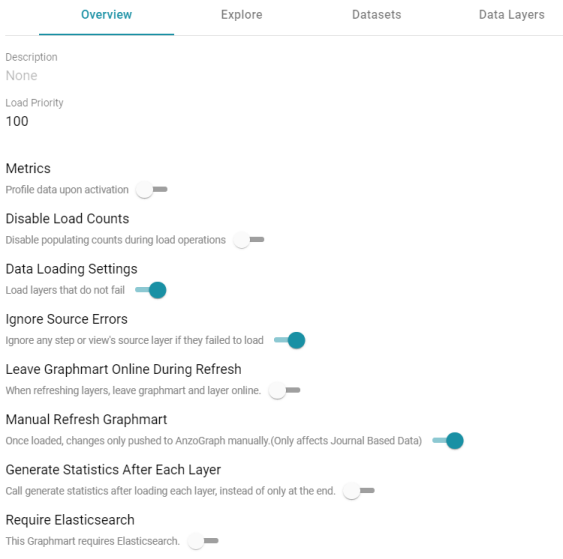Graphmart Settings Reference
This topic describes the graphmart configuration settings that are available on the graphmart Overview tab.

| Setting | Description |
|---|---|
| Load Priority | If you want Anzo to prioritize the order in which graphmarts are activated when reconnecting to AnzoGraph or resetting and reloading AnzoGraph, you can designate a Load Priority for each graphmart. When reloading AnzoGraph, Anzo activates the graphmarts in sequence, starting with the lowest Load Priority number. The default value is 100. |
| Metrics | Profile Data Upon Activation
This setting is disabled by default and controls whether a data profile is automatically generated each time the graphmart is activated. For information about data profiles, see Generating a Graphmart Data Profile. |
| Disable Load Counts | Disable Populating Counts During Load Operations
This setting is disabled by default controls whether Anzo periodically sends |
| Data Loading Settings | Load Layers that Do Not Fail
This setting is enabled by default and controls what to do if a data layer fails during graphmart activation. When enabled (the default setting), the graphmart is configured to load all layers that succeed and skip any layers that fail. When disabled, the entire graphmart activation is aborted if any layer fails. |
| Ignore Source Errors | Ignore any Step or View's Source Layer if they Failed to Load
This setting is enabled by default and controls what to do if a source that is referenced by a step or view fails to load. For example, if the source for a Query Step is set to "All Previous Layers Within Graphmart" and one of the previous layers fails to load, this setting controls whether to run the Query Step but ignore the failed layer or fail the step since one of the sources failed. If Ignore Source Errors is enabled (the default setting), Anzo ignores the failed source and runs the step against the sources that did not fail. For example, if USING <layer1> USING <layer2> USING <layer3> And layer1 failed to load, Anzo runs the Query Step but ignores layer1 and automatically changes the query to USING <layer2> USING <layer3> If Ignore Source Errors is disabled and a source layer fails, any steps or views that use that source will also fail since the source is not available. |
| Leave Graphmart Online During Refresh | When Refreshing Layers, Leave Graphmart and Layer Online
This setting is disabled by default and controls whether a graphmart remains online while it is being refreshed in AnzoGraph. When this option is enabled, if a user clicks the Refresh button to refresh a graphmart (or the Refresh icon on a data layer), Anzo copies the existing layers into temporary graphs so that the data remains online while the original graphs are refreshed. When the refresh is complete, the temporary graphs are deleted. This setting applies only to Refresh operations. If Leave Graphmart Online During Refresh is enabled and a user clicks Reload, the data layers will not remain online. During reloads all of the data is dropped and then loaded again. |
| Manual Refresh Graphmart | Once Loaded, Changes only Pushed to AnzoGraph Manually (Only Affects Journal Based Data)
This setting is enabled by default and controls whether changes to a dataset in this graphmart are automatically deployed to AnzoGraph without requiring a manual refresh or reload of the graphmart. This setting only applies to graphmarts with Load Dataset Steps that load a journal-based data set, such as a system metadata graph. When this option is enabled, changes to the journal-based data set are only deployed to AnzoGraph when the graphmart is manually reloaded or refreshed. When this option is disabled, changes to the dataset are automatically loaded to AnzoGraph without requiring a manual refresh. |
| Generate Statistics After Each Layer | Call Generate Statistics after Loading Each Layer, Instead of Only at the End
Typically the AnzoGraph connection is configured to automatically initiate AnzoGraph's internal statistics gathering queries after loading a graphmart. However, if a user refreshes individual layers rather than the entire graphmart, those queries are not triggered. Enabling this setting initiates the statistics gathering queries each time a layer is loaded. This helps the AnzoGraph query planner generate ideal query execution plans for queries that are run against the refreshed data layers. |
| Require Elasticsearch | This Graphmart Requires Elasticsearch
This setting is disabled by default. If you plan to include unstructured datasets in this graphmart or configure a data layer that creates an Elasticsearch index, you can enable this option to ensure that Anzo validates the connection to Elasticsearch whenever this graphmart is activated, reloaded, or refreshed. |